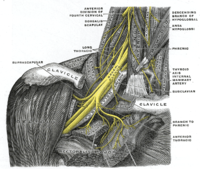
Photo from wikipedia
We evaluated whether pre‐emptive analgesia with a pre‐operative ultrasound‐guided infraclavicular brachial plexus block resulted in better postoperative analgesia than an identical block performed postoperatively. Fifty‐two patients undergoing fixation of a… Click to show full abstract
We evaluated whether pre‐emptive analgesia with a pre‐operative ultrasound‐guided infraclavicular brachial plexus block resulted in better postoperative analgesia than an identical block performed postoperatively. Fifty‐two patients undergoing fixation of a fractured radius were included. All patients received general anaesthesia with remifentanil and propofol. Patients were randomly allocated into two groups: a pre‐operative block or a postoperative block with 0.5 ml.kg−1 ropivacaine 0.75%. After surgery, all patients received regular paracetamol plus opioids for breakthrough pain. Mean (SD) time to first rescue analgesic after emergence from general anaesthesia was 544 (217) min in the pre‐operative block group compared with 343 (316) min in the postoperative block group (p = 0.015). Postoperative pain scores were higher and more patients required rescue analgesia during the first 4 h after surgery in the postoperative block group. There were no significant differences in plasma stress mediators between the groups. Analgesic consumption was lower at day seven in the pre‐operative block group. Pain was described as very strong at block resolution in 27 (63%) patients and 26 (76%) had episodes of mild pain after 6 months. We conclude that a pre‐operative ultrasound‐guided infraclavicular brachial plexus block provides longer and better analgesia in the acute postoperative period compared with an identical postoperative block in patients undergoing surgery for fractured radius.
Journal Title: Anaesthesia
Year Published: 2017
Link to full text (if available)
Share on Social Media: Sign Up to like & get
recommendations!